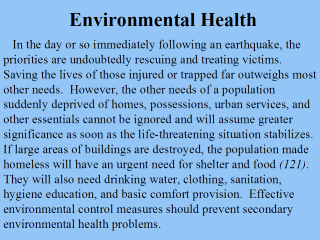 |
Surveillance
for Communicable Diseases Rumors and fears of epidemics generally
circulate in the aftermath of disasters, and earthquakes are no exception.
Outbreaks of infectious disease generally have not followed earthquakes in
other countries and are unlikely to occur in the United States. Health
officials, however, should be prepared to recommend appropriate sanitary
precautions and to dispel unfounded rumors and inaccurate information. They
should set up a disease surveillance mechanism appropriate to the
circumstances and provide regular reports to disaster-response officials.
Any unusually high incidence of disease should be investigated and control
measures implemented. Mass vaccination campaigns not based on results of
public health surveillance are inappropriate following earthquakes. |
